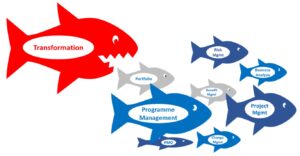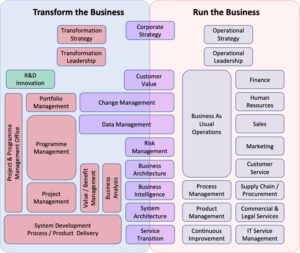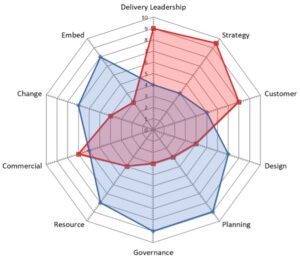“There are two kinds of people in this world. Those who run businesses and those who transform businesses. As a Transformation Director, you transform” [1]. This may be a binary view of the business world, but it serves a purpose. Those involved in the steady state running of a business, the COO, the CFO, the HR Director, are generally recognised professionals who have recognised qualifications. Transformation? Not so much. It is still the wild west out there… but there is enough expertise and order for that to change.
Transformation Directors (TDs) like to portray themselves as gnarly, battle scarred change leaders. They like to ride into town, with or without a poncho, deliver change, take a few dollars more, leave the good townsfolk to their new world and move on to the next county. Harsh? Maybe, but Transformation needn’t be a gunslinging analogy. With definition, scope and capability Transformation can become a recognised and qualified profession. Here are my recommendations for all three and of course they are there to be shot at.
The Definition
Kotter told us why transformation efforts fail in 1995 without defining what Transformation actually is. We’ve been living without a clear definition of transformation ever since. Until recently that is. Change Associates provided a fine definition that usurped the incumbent wording on Wikipedia:
“Business Transformation is the process of fundamentally changing the systems, processes, people and technology across a whole business or business unit, to achieve measurable improvements in efficiency, effectiveness and stakeholder satisfaction. As such, a business transformation project is likely to include any number of change management projects, each focused on an individual process, system, technology, team or department.” David Cruise, Change Associates, 2017.
McKinsey provided a pithy and powerful definitionthat defined Transformation as a program of work. So, while change may be constant, Transformation is a programme and therefore temporary. A Chief Transformation Officer (CTO) may have many initiatives in a continuously evolving transformation portfolio, but each initiative has a life span and an end.
“Transformation with a capital T, which we define as an intense, organization-wide program to enhance performance (an earnings improvement of 25 percent or more, for example) and to boost organizational health”, Bucy, Hall and Yakola, McKinsey, 2016
Both definitions agree that scale is important, Transformation is organisation wide and has many cross functional elements to it. Add the customer focus (a cornerstone of digital transformation) and I believe the definition of Transformation has evolved to level that can engage CEOs and TDs alike:
“Business Transformation is a programme or portfolio of work that fundamentally improves the people, process and technology capability across a whole organisation or organisational unit, to achieve measurable improvements in customer and stakeholder satisfaction”.
This definition of Business Transformation benefits from two supporting concepts.
- A business transformation programme is likely to include any number of interdependent change management projects, each focused on a specific process, system, technology, team or department objective.
- Where a project achieves an output, a programme achieves an outcome, transformation achieves a step change in business performance.
The first is clear: transformation is dependent on multiple teams in multiple disciplines. Everyone IT, HR, Finance must be on the bus (or stagecoach) and the management of dependencies across these silos requires evolved Programme Management Office (PMO) skills.
The second is new: taking the concept of scale a step further, it is necessary to divide delivery programmes into a) simple initiatives that deliver across multiple projects or workstreams but do not generate a transformational change and b) wider transformational programmes or a collection of initiatives (portfolio) that delivers a step change in performance, measurable improvements at an organisational level.
The Scope
Transformation isn’t just a matter of programme delivery or portfolio management, it’s much bigger than that. A Transformation Director or Chief Transformation Officer will expect to have mastered or be at least highly credible in many capabilities from Business Analysis to Programme Management. Hence in the context of current professions, Transformation has the potential to become the big fish umbrella term that engulfs all other change disciplines.

Figure 1: Transformation – big fish umbrella term for the whole profession, (or red herring?)
Is Transformation a pseudonym for Change Management? Absolutely not. Put simply, no Change Management model provides the necessary guidance or framework for operational change (transformation).
Kotter, Kubler Ross, Deming, Prosci ADKAR and now ‘nudge’ all provide great models and tools, but none provide the guts of what is required to deliver transformation, none provide the full toolbox. Smartsheet neatly summarized this argument with a compelling table view of major change management models, each with their benefits and limitations listed. A canter through that list illustrates how change management will help you navigate the emotional and behavioural battlefield of transformation, but not give you the bridge or gunpowder to make things actually happen.
So, what is the scope of Transformation in existing terms? What current change disciplines fall under this umbrella term and how can a Transformation professional describe their skillset?

Figure 2: The Transformation Landscape v1.0 – Defined as Professional Capabilities
Any attempt to create a professional skills map of Transformation will create argument and agreement in equal measure. Does Project Management include Risk Management and more? Should Programme Management include Benefits / Value Management? Where does Agile fit in?
These arguments have been conveniently parked here to develop version 1.0 of this map and highlight some key viewpoints:
- The Portfolio / Programme / Project Management (P3M) “stack” is the backbone of capabilities that deliver Transformation, but Transformation does not sit on top – instead, P3M sits within Transformation
- PMO (Project, Programme and Portfolio) is the central co-ordinating capability and function that holds Transformation together at all levels. PMO continues to evolve and should be recognised as the engine room of Transformation
- Some disciplines span the chasm of Transformation and Business As Usual (BAU). Risk Management, Business and System Architecture require an integrated view of operations before, during and after Transforming it
- Innovation is a Transformation discipline. Only by integrating the disruption, art-of-the-possible and new technology idea with other Transformation disciplines can benefits (principally revenue) be realized
- Change Management is a capability and a “how-to” tool. It does not provide a framework of what to do and therefore sits alongside P3M in this world
The Capability
Understanding what Transformation is by piecing together the fabric of professional disciplines in change management is useful, but there is a better way. Transformation is best described through capability. There are three elements:
- Transformational Leadership Capability, i.e. the capability of an organisation’s leadership to drive, empower and champion a Transformation
- Transformation Delivery Capability, i.e. the capability of the Transformation team to deliver against the vision and the plan
- Organisational Readiness, i.e. where the organisation currently is with respect to current understanding and maturity of processes, technology and people
Transformational Leadership Capability
The need for Transformational Leadership is defined in the first article in this series alongside Transformation Delivery Capability. Although not scientific, Leadership capability can be measured and the results illustrate different shapes of Leadership. Recognising and acting on that shape of leadership is key to Transformation success.

Figure 3: Transformation Leadership Capability – measured
Visionary Leadership (in Blue) – where the C-Suite provide the vision, the mission, the motivational communications and the permission to succeed. However, the detail is potentially at risk including the alignment of initiatives. He time commitment may also be missing – just when the decision is required.
Managerial Leadership (in red) – where Leadership is visible, involved and accountable. However, they may not be so charismatic or inspiring and the vision could be lost in the various Boards, forums and spreadsheets
Transformation Delivery Capability
Transformation Delivery is where the theories, frameworks, training and certifications can be argued, re-badged and re-argued at length. The bottom line is that successful Transformation is dependent on ten core capabilities. Each can be measured and evaluated to indicate what “shape” an organisation’s Transformation is in.

Figure 4: Transformation Delivery Capability – measured
Process Led Transformation (in Blue) – where the best practice manuals are adopted. The governance is in place and the operating model is designed. Full speed might be achieved but not necessarily in the right direction. Will the programme meet changing customer needs and make a commercial difference?
Strategy Led Transformation (in red) – where the commercial and strategic needs are driving the programme. However, the PMO might not be resourced, the plans not providing the rigour needed and delivery success not as certain
Organisational Readiness
The starting point for Transformation is often overlooked. Leadership and Delivery Capability may be highly evolved, but if the challenge is just too big then any Transformation mission can fail. Illustrating two flavours of Organisational Readiness demonstrates the challenges:

Figure 5: Organisational Readiness – measured
A financially and commercially capable organisation (in blue) will be ready for benefits management in P&L terms, commercially focused change and third party management. In contrast the organisation may not have defined processes, service management discipline or understand the people challenge of any change.
A process and service management capable organisation (in red) will have a clearer understanding of the operational foundations upon which to deliver Transformation. However, the financial and commercial foundations may be less well defined and understood.
Summary and Conclusions
Organisations who have “two kinds of people” are able to run the business and transform the business simultaneously. For those who do not, the prognosis is not so good. In fact, it is often bad and sometimes ugly.
Transformation is homing in on a succinct written definition of what it is and what it does. However, the way of defining and understanding Transformation is in capability terms. Transformational Leadership, Transformation Delivery Capability and Organisational Readiness are all defined in and are all measurable.
The talent needed to deliver Transformation comes from a growing pool of increasingly professional individuals. The scope of skills within that Transformation talent pool are well understood, they include recognised professions and established qualifications. However, there is an opportunity to pull these multiple strands of capability together to create a Transformation profession with modular qualifications and a Transformation certification.
Far from being a gun slinging analogy, Transformation is a recognised business capability and recognised profession it just needs a little finesse, co-ordination and the qualification to pull it together.
CB
—————————————————————————————————————
[1]: This line is of course inspired by Clint Eastwood’s character in the film “The Good, The Bad and The Ugly”: “You see, in this world there’s two kinds of people, my friend: Those with loaded guns and those who dig. You dig.”
Article by channel:
Everything you need to know about Digital Transformation
The best articles, news and events direct to your inbox
Read more articles tagged: Change & Transformation, Leadership






